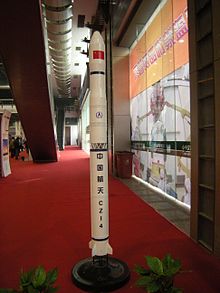Long March 4

Long March 4 , shortly LM-4 ( Chinese 長征四號 / 长征四号 , Pinyin Changzheng Sihao shortly CZ-4 ) designates one of the Shanghai Academy of Space Technology (SAST), a division of the China Aerospace Science and Technology Corporation , produced Family of three-stage launch vehicles based on the two-stage Fengbao 1 launch vehicle from 1969.
Versions
| 4A | 4B | 4C |
|---|---|---|
 |
 |

|
Long march 4A
After Mao Zedong had approved the development of a geostationary communications satellite - later called Dong Fang Hong 2 - on March 31, 1975 , the then Second Bureau for Mechanical and Electrical Engineering Shanghai was given the order in 1978 to deliver a three-stage launcher based on his old Fengbao 1 develop that could carry said satellites into a geostationary transfer orbit . In 1979 the actual development work began, but was stopped in March 1982 because the requirement profile had changed. Now a new version of the rocket called the "Long March 4A" was supposed to move China's first weather satellite Fengyun 1A , also to be developed at the Second Bureau, into a sun-synchronous orbit . This was achieved on the first flight of the rocket on September 6, 1988. On the second and final launch on September 3, 1990, Feng Yun 1B was then launched. After that, the missile was replaced by the CZ-4B.
Long march 4B
A further developed third stage and two different payload fairings were used on the CZ-4B. These had a length of 4.91 meters and 2.90 meters in diameter and 8.48 meters in length and 3.35 meters in diameter. The first flight took place on May 10, 1999 with Feng Yun 1C and Shi Jian 5 on board.
Long march 4C
The CZ-4C uses a re-ignitable third stage, modified stage adapters and a large payload fairing. Her maiden flight took place on April 26, 2006, when she put the YaoGan WeiXing-1 satellite into orbit.
Technical specifications
The engines of all three stages use the liquid fuels UDMH and nitrous tetroxide.
| model | CZ-4A | CZ-4B | CZ-4C |
|---|---|---|---|
| stages | 3 | ||
| height | 41.90 m | 45.80 m | 45.80 m |
| diameter | 3.35 m | ||
| Takeoff mass | 249 t | 253 t | 250 t |
| Start thrust | 2,960 kN | 2,962 kN | 2,962 kN |
| payload | 4,680 kg LEO 1,100 kg GTO |
4,800 kg LEO 2,790 kg SSO |
4,200 kg LEO 2,790 kg SSO |
| 1st stage | |||
| Type | SAST L 180 | ||
| height | 24.66 m | ||
| diameter | 3.35 m | ||
| Empty mass | 9.5 t | ||
| Takeoff mass | 192 t | ||
| Engine | a YF-21B with four combustion chambers | ||
| Burn time | 158 s | ||
| 2nd stage | |||
| Type | SAST L 35 | ||
| height | 7.51 m | ||
| diameter | 3.35 m | ||
| Empty mass | 4 t | ||
| Takeoff mass | 39.55 t | ||
| Engine | a YF-24B with 831 kN thrust | ||
| Burn time | 131 s | ||
| 3rd stage | |||
| Type | SAST CZ-4A-3 | ||
| height | 4.82 m | 5.15 m | ? |
| diameter | 2.9 m | 2.9 m | ? |
| Empty mass | 1.0 t | 1.0 t | ? |
| Takeoff mass | 15.15 t | 18 t | ? |
| Engine | two YF-40s with 98.1 kN thrust | two YF-40A with 100.8 kN thrust | |
| Burn time | 433 s | 500 s | ? |
See also
Individual evidence
- ↑ 李鸣生: 我国 首颗 通信 卫星 发射 内幕. In: hbgrb.net. December 23, 2013, accessed July 8, 2020 (Chinese).
- ↑ a b Mark Wade: Chang Zheng 4 in the Encyclopedia Astronautica (English)
- ↑ 长征 四号. In: weapon.huanqiu.com. Retrieved July 4, 2020 (Chinese).
- ↑ Eugen Reichl: The rocket type book. Motorbuch-Verlag, Stuttgart 2007, ISBN 978-3-613-02788-6 .
- ↑ Gunter Krebs: CZ-4C (Chang Zheng-4C). Gunter's Space Page, January 3, 2019, accessed on January 18, 2019 .